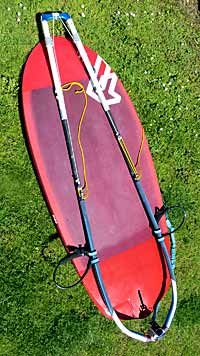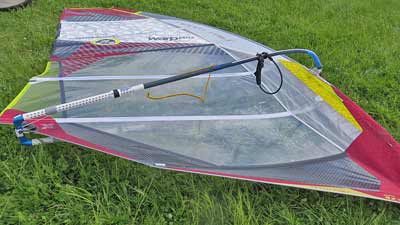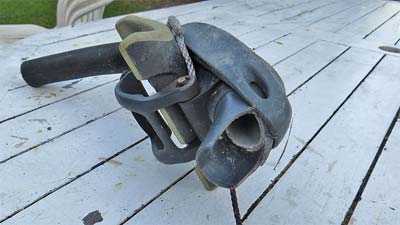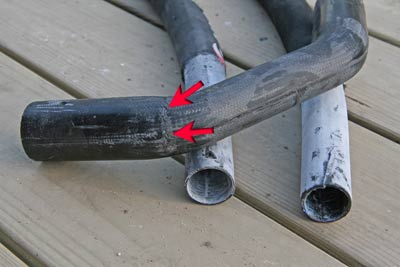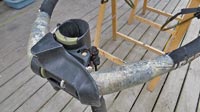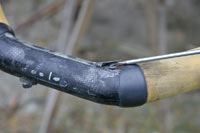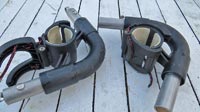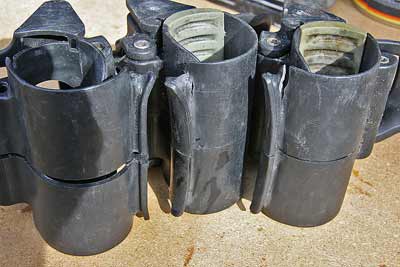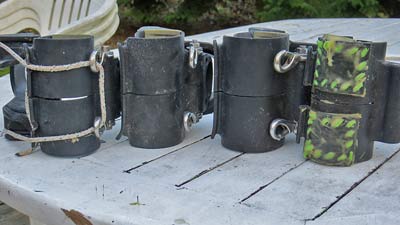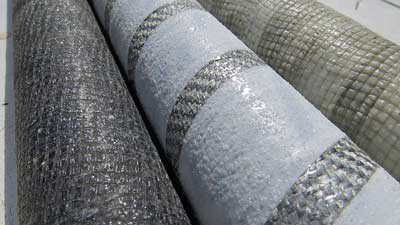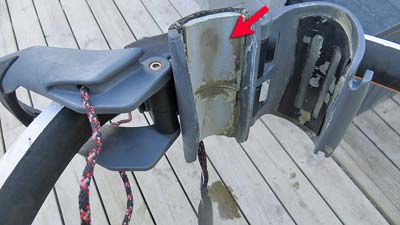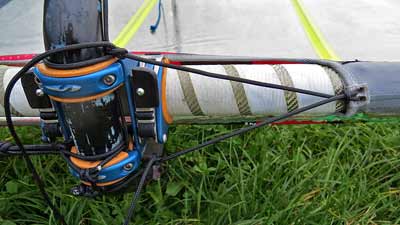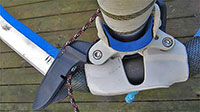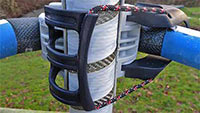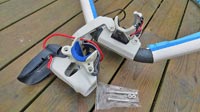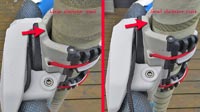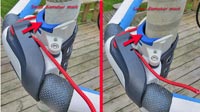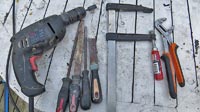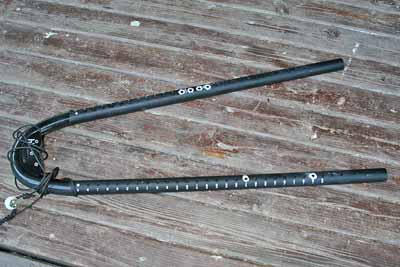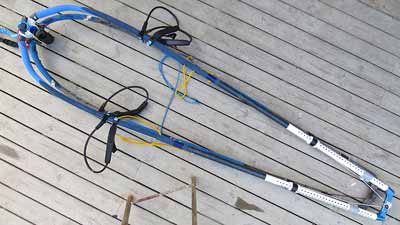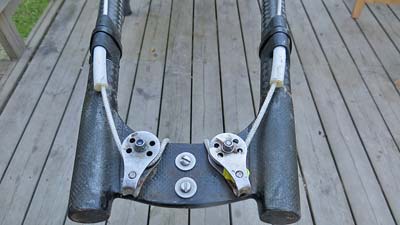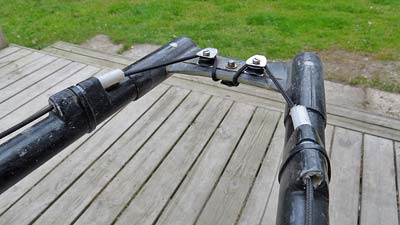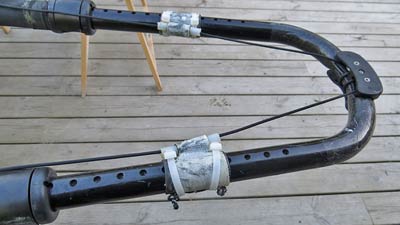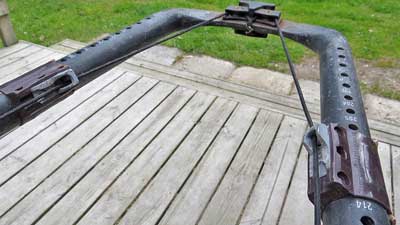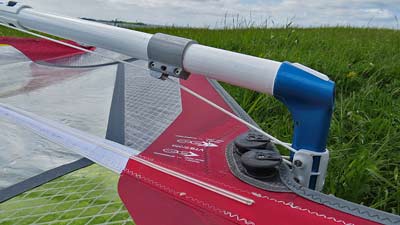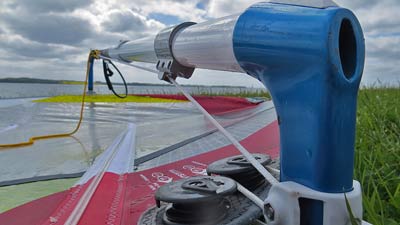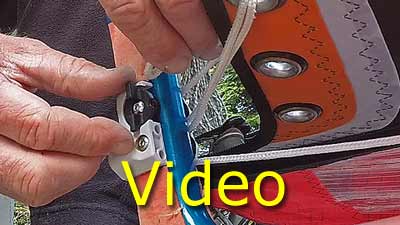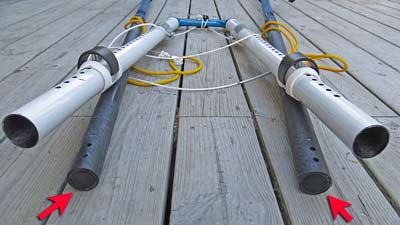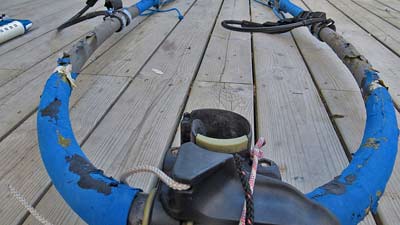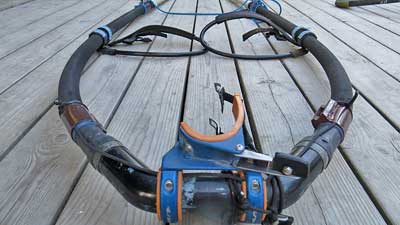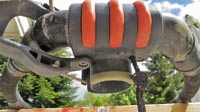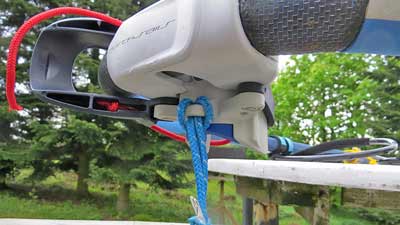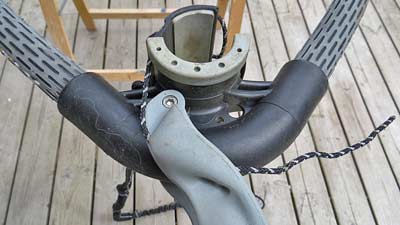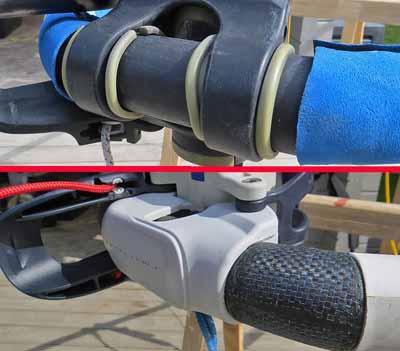May 2015, updated September 2015.
The North Platinum 190-250 cm boom.
A review - wrapped in a
general boom discussion.
In the late autumn of
2014 I got a brand new North Platinum 190-250 cm boom for use with my big
slalom gear. Due to
my fragile body sustaining some smaller injuries, the boom was not wetted
until early in 2015, but although I haven't used the boom that much, a
clear
image of its function and performance
has certainly been formed.
So far, the boom
has solely been used with a North Warp F2013 9.2 on a RRD X-Fire 129 and
a Fanatic Falcon 152.
A North Warp F2013 9.2 sail with the North Platinum 190-250 cm boom.
Click the picture to enlarge.
There'll be plenty of
words below, so I'll not tire you with a description of the key features
of the boom. Instead I can refer to this (coloured) description from the
North homepage:
http://www.north-windsurf.com/eng/nodes/display/product/platinum-series-1
and this presentation of the general boom technology of
the company:
http://www.north-windsurf.com/eng/nodes/display/pages/boom-technology.
The review.
In this review I'll use my experience with booms from other brands as a reference. That is, the Platinum boom will be "measured" by comparing it to other solutions, both good and flawed, that I've come across over the years.
With a personal, but
rather vague, order of priority, the most important qualities for booms
this size are listed below. They
are as follows:
1.
The main parts of booms this size must be manufactured from carbon fiber.
Generally,
carbon booms are stronger, more durable and stiffer than aluminum booms.
And furthermore,
if
a carbon boom weakens,
you'll very often have a
chance of noticing
unhealthy noises and locating
cracks before any fatality, whereas aluminum booms
have an unfortunate tendency to explode without warning. Contrary to carbon, aluminum develops
fragility from continuously bending,
and broken aluminum isn't repairable. However, if you
locate
some cracks on a carbon boom, it's
sometimes
possible to file/sand down some of the bad material and add
new layers of carbon or glass fiber weave. And of course, you can also
strengthen sound areas of a carbon boom as
preventive measures.
The remains of an exploded Neil Pryde X6 boom. The
aluminum made X6 boom has an extremely bad reputation -
and a well deserved one!
Click the picture to enlarge.
The front piece of a Fiberspar carbon boom has cracked. Judging from
where the cracks are located, Repairing the front is actualy feasible.
- although perhaps not advisable.
Click the picture to enlarge.
How does the Platinum
boom meet this demand?
Well, my new
Platinum 190-250 cm boom is
indeed made from carbon fiber - but more than that: Carbon is not carbon
- in the sense that carbon fiber laminated with a lot of resins is not
nearly as strong as carbon fiber laminated with just enough resins. A
(say) 2 millimeters carbon laminate consisting of relatively few layers
of fiber, bonded together with lots of resins, is not nearly as strong
as lots of layers of fiber, bonded together with very little resins.
North claims that the
Platinum boom is manufactured from pre-wetted (prepreg) carbon weave, so
apparently the carbon weave contains only a minimum of resins. Simply
from feel I can say that the exposed carbon on the Platinum boom is a
lot more scratch resistant than any carbon boom I've owned. I see this
as a clear sign of a very tough boom, probably the toughest boom in my
arsenal. And just an interesting detail: Some of my carbon booms have
signs of casting, indicating that two halves of tubes are glued
together, but not precisely aligned. The Platinum boom has no such signs
...
2.
The boom front must
be integrated with the tubes (a monocoque construction).
Among the carbon
booms, to my knowledge only the Nautix carbon booms still have a "loose"
front section/head that's connected to the tubes with glue (epoxy?). The
old Fiberspar carbon booms also had a separate boom front that was glued to the tubes.
Although seemingly
old fashioned, I'll always prefer this system
if there's any risk that
the boom front of a monocoque construction will crack. For instance,
if
the front cracked on a Fiberspar boom you could always buy another front
and glue the boom together - while the frequently cracked fronts on
(only earlier?) Neil Pryde X9 booms imply trashing the entire boom.
A Fiberspar carbon boom (with Maui
Sails head) reinforced with glass
fiber weave for preventive reasons.
Click the picture to enlarge.
A Neil Pryde X9 boom front shows
some ominous cracks. Repairable?
Look at the next picture.
Click the picture to enlarge.
The head das been removed from
the NP X9 boom front. The location
and the seriousness of the cracks
tell that there's no salvation for
this boom.
Click the picture to enlarge.
A couple of old-type Nautix
integrated boom fronts/heads.
The front/head to the right is meant
to be laminated into Nautix carbon
tubes. Compared to a fragile
monocoque construction, I'll
always prefer this system.
Click the picture to enlarge.
How does the Platinum
boom meet this demand?
The Platinum boom is
a monocoque construction, where you'll have to hope for durability of
the boom front as there's no possibility for renewal. However, to my
knowledge boom front cracking problems isn't widespread these days, and
with the very strong appearance of the Platinum boom I foresee no
problems in this respect.
3.
The boom head clamp
mechanism must grab the mast with NO tendency to slide down.
I've very seldom possessed booms that didn't slide down the mast with 7.8'ish sails and bigger. Frankly, I don't understand why this issue isn't discussed more among windsurfers, and I suspect that many sailors simply are not aware, and don't give it a thought, why the control of the sail gets better and why the speed and liveliness of the board get worse during a session. In short: Booms slide down without many sailors giving it a thought.
One of the very few
exceptions from the enervating sliding-down problem is the Nautix booms
(with a "loose" front piece, not a monocoque construction). And from the
other end of the spectrum my Maui Sails booms have always been sliding
down. And
mentioning
the Maui Sails booms - attempting to tightening the head, the only
consequence is to crack it. I've used fortunes on
renewing
cracked MS
booms heads, and I'm very surprised that the MS people think they can
get away with blaming the costumers for this defect: There's simply
no
way to avoid boom head sliding
and at the same
time avoiding cracks for the Maui Sails heads. You'll have to choose - a
cracked boom head or a sliding
down boom head.
The classic Maui Sails boom head problem: You'll have to choose
between boom slip or a cracked head. Here are e few heads from
my personal collection.
Click the picture to enlarge.
In desperation over the waste of money for replacement for the
cracked Maui Sails heads I've tried to come up with alternatives
for trashing them. Please note that there're no "overlapping"
heads in the two pictures.
The final solution was to replace the heads with the very rugged
Streamlined boom heads that fit perfectly to the Maui Sails
boom fronts.
Click the picture to enlarge.
The boom sliding problem is monstrous irritating, and I've made it to a procedure to put on an anti-skid coating in the boom area of all my masts as soon as they arrive from the shop. This helps, but for some of my booms (Maui Sails, Streamlined, Neil Pryde and others) it only reduces the problem.
A couple of ways to increase the friction between boom and mast. In
both ways the boom areas of the masts are wetted with a thin layer
of epoxy. The areas are then either covered with a rough masked
nylon cloth (the masts to the left and to the right), and the cloth
are removed when the epoxy is hardened.
The mast in the middle is treated the same way as when putting
an anti-skid layer on your boards (epoxy sprinkled with sugar that's
washed away, when the epoxy is hardened).
More on the subject here:
http://peterman.dk/windsurf-anti-boom-slip01-1200.htm
Click the picture to enlarge.
An Aeron boom head equipped with pieces of rubber/soft plastic,
taken from an old Nautix boom head. I'm astonished why some
brands seem to think that hard plastic against a smooth mast can
create sufficient friction to avoid boom sliding.
Click the picture to enlarge.
Update September 2015.
The simplest mean's
often the best: A string threaded through a couple of holes (made with a
soldering iron) is tied to the boom front. In the picture the
anti-boom-slipping line is used with a North Warp 8.6, rigged on a
Platinum 490 with a Nautix boom with a Streamlined boom head (older
type). Until this solution the Streamlined boom head ALWAYS slipped a
couple of cm every 10 minutes - especially in bumpy conditions.
The "system" is
quick made (a couple of minutes) and very, very effective. And so far
I've noticed none negative effects on the sail whatsoever. A no-nonsense
solution that works!
The picture's from
the test session. No need to fasten the boom head in kind of double
string. A single string will do.
Click the picture to enlarge.
How does the Platinum
boom meet this demand?
Perhaps you think
that having a boom that doesn't slide down your mast is a banality and
truism. In my opinion it's not.
I've used the
Platinum boom with two original heads (iFRONT 1.0 in the stiffest setup
and iFront 2.0 in the "stiffness III" version).
Neither of them
showed the slightest tendency to slide down
the mast.
It's
my
experience that
such
non-slipping quality isn't that common.
Update February 2016.
Trimming boom height on the water.
As said, the Platinum iFront 2.0 clamps very securely onto the mast. It
does so by almost sucking the mast with the friction pad - in fact the
friction pad gets in contact with the mast way before the clamp is fully
closed.
In a review of the
Platinum Aero 190-250 boom, Andreas Wale
(who is otherwise very satisfied with the boom) from
Sweden has pointed out that the early contact between the
friction pad and mast can cause a problem if you're the kind of guy that
frequently adjusts the boom height on the water: To release the iFront
2.0 sufficient from the mast to allow boom height adjustments, you'll
have to open the lever fully, and by doing so you risk (or: You're damn
sure) that the tightening string gets loose from the cuff.
It would be unfair
to criticize that the Platinum boom head ties firmly to the mast very
early when operating the lever. In fact, this is probably the cause why
it isn't member of the annoying "sliding down the mast syndrome family"
- a family way too big!
However, if you're
the kind of sailor that use to trim the boom height on the water, it
would be nice if you could open the lever without the string falling off
the cuff, and thus avoid the fiddling issue to replace the string
before clamping the boom in a new position.
Without going into
details I think it would be pretty easy for the gifted North people to
help the guys with the habit of trimming the boom height on the water -
for instance by "locking" the string better to the cuff. By doing so
North would satisfy sailors that focuses on easy boom height trimming on
the water (like Andreas)
and sailors that focuses on boom heads that
don't slide down the mast (like me).
The iFront 2.0 clamp has to be
almost fully opened to allow the
boom height to be adjusted.
Click the picture to enlarge.
When opening the clamp fully, the
string almost certainly falls off the
cuff - unless you keep the string
tight by simultaniously pullling
back the cuff (as done here).
Click the picture to enlarge.
4. The boom head clamp mechanism must not crush the mast
.
The Platinum 190-250
cm boom was delivered with a iFRONT 1.0 boom head. The head can be
stiffened up by moving around a couple of screws, and as the boom was
intended for use with a race sail, it was
stiffened max. For curiosity - and for this review - I ordered
the new
2015 iFront 2.0 boom head ("Stiffness III" version) and have been
using this head the last couple of sessions.
No need to go into
technical details, but from the view of the user the main difference
between the heads seems to be that the new head accepts different mast
diameters somewhat better than the iFront 1.0. As said, also the iFront
1.0 sits firmly on the mast, but it seems that it point loads thicker
masts more than the new iFront 2.0. The iFront 2.0 simply seems to be
more careful to larger diameter masts. As I (for reasons described here:
http://peterman.dk/windsurf-north-warp-1000.html) am tied to use the
older large diameter pre-drop shape Platinum 490 cm masts for my Warp
9.2, I've decided to use the iFront 2.0 boom head.
The Platinum 190-250 cm boom
with the iFront 1.0, it was delivered
with - placed behind the new 2015
iFront 2.0 boom head.
Click the picture to enlarge.
The ability of the iFront 1.0 boom
head to fit tight to an older North
Platinum 490 cm mast and the
new Platinum 490 cm mast.
Click the picture to enlarge.
The ability of the iFront 2.0 boom
head to fit tight to an older North
Platinum 490 cm mast and the
new Platinum 490 cm mast
Click the picture to enlarge.
It always comes as a surprise just
how time consuming it is to fit a
new boom head to a boom front.
Fitting a iFront 2.0 boom head to
a Platinum boom front certainly
isn't an exception - indicated by
the tools used.
Click the picture to enlarge.
How does the Platinum
boom meet this demand?
I don't foresee any
problems with durability of my masts
when used with the iFront 2.0 boom
head.
5. No water in the boom, please
!
Water in the boom is
annoying - and unfortunately
pretty
common. Objectively I'm not sure that it means a lot to have a boom that drinks some water. But mentally
it's very de-motivating to listen to the gurgling noise of water from
the boom and see the water pouring out of the tail when coming ashore.
It's not a problem to
cork the tail end of a boom to avoid this kind of water entrance.
However, it's a real problem to fix the most common source
of the water
entrance problem - the holes (hollow depressions) for the adjustment
pins. Holes that are intended
not to give access for water
to
the interior
of the tail end - but holes that due to lousy manufacturing quality very
often suck water.
As
said, it's
a very
elaborate work to try to repair the leakage in the pin holes, and often
it's much better to simply to drill some holes for draining water out in
back of the tail end or underneath of the tail end. This way, of course,
water can get into the boom, but it also gets out
again as soon as you lift
the boom from the water.
The gurgling noise from this almost new Neil Pryde X9 tail end indicated
water entrance. A pressure test revealed that 6 pin holes leaked (here
encircled with a white marker). Result: The water gets in easily - but is
almost impossible to get out.
Click the picture to enlarge.
How does the Platinum
boom meet this demand?
The North people has
taken the consequence of the trapped-water problem and have given water
free access to get into the tail end of the Platinum boom - and
more important: Free
access to get out as soon as it gets out of the water. This is a
no-nonsense solution, that furthermore allows the tail
end
to be very light (no need
to laminate extra
material inside the tail
end tubes
to place the pin holes in)
and allows the
tail end to fit outside the tubes for stiffness reasons. Simple and
elegant!
6.
The width of the boom
shall accept the profile depth of the sail - but only just.
I think many of us
have experimented with shortening booms - for several reasons:
Substituting an older race sail with a new one in the same size often
imply an 10-20cm shorter boom length because of the trend with cut outs
at the clew. Another source for boom shortening experiments is the large
stock of very long booms - up to 310 cm on length - that some shops sell
very cheaply because of the diminishing market for very big formula
sails;
carbon
booms of high quality that only have a chance for being used and
sold if shortened.
Anyway, from the boom
shortening business I have several times
ended up using a boom
that felt too
wide. The trim simply were wrong, and the manoeuvres felt awkward. My
son and I have 7 booms for sails in the 6.3 - 9.2 sizes, and the width
of the booms (inside the tubes, between the harness lines) vary from 50
- 59 cm. Personally, for a 9.0 - 9.5 sail on a large slalom board, I
feel that a boom width between 50 cm to 55 cm is best. A little
dependent of the tail width of the boom, I prefer that the sail touches
the boom tubes
slightly from the outhaul
clam cleats backwards when releasing
the outhaul for a downwind run.
How does the Platinum
boom meet this demand?
The Platinum 190-250
cm boom has a width of 50,5 cm between the harness lines (for a Warp
9.2). That's relatively narrow, but for me that's spot on. Also because
of the outline of the boom (see later).
7.
The shape of the boom
must be classic with no "new-school" bend curves or the like of the
tubes.
For larger booms I don't fancy "new school" shaped booms. Bigger sails have the draft a long way back from the mast, so I find no reason to drastically change the proven boom shape forward towards the boom head. With smaller sails, where the harness lines and your hands are placed closer to the mast, perhaps it's another story.
How does the Platinum
boom meet this demand?
The Platinum 190-250
cm boom has a reasonable classic shape. The tail is moderately wide, and
the shape from the front to the wide point is certainly not what can be
called
a
"new-school" shape.
However, the shape of this section is kind of segmented in
a couple of fairly
"straight" curves, that allow the front hand
to be almost in line with the back hand. This segmented curve is subtle,
I must admit, but I think it's there.
Perhaps that's the reason why
the boom simply
feels
nice to have in your hands.
The Platinum 190-250 cm boom is placed upon a Maui Sails boom.
The shapes of the tubes between the harness lines end the boom
head differ a little, giving the Platinum boom perhaps a little
more natural feel for your front hand.
Click the picture to enlarge.
8. The boom must be stiff, also fully extended
.
The stiffness issue
isn't as urgent as earlier. The need for very long (formula) booms kind
of standardized
the contemporary
appearance
of bigger carbon booms, so that in the harness line
area the diameter is "grab-friendly", while the
diameter towards the
front and
tail is oversized. This boom style has proliferated
down the slalom sizes, although the need for oversized tails isn't that
urgent here. Frankly, sailing with 7.0-7.8 and smaller slalom sails I
prefer to have an ordinary old-style carbon boom in my hands - like the
good old Fiberspar booms without the heavy oversized tails, that often
feel
a bit
un-balanced.
However, for sailing
with slalom sails bigger than 7.8 meter, the stiffness of the oversized
tails is a benefit. Before receiving the Platinum 190-250 cm boom I
sailed my Warp 9.2 with an old Fiberspar boom (with Streamlined head)
without oversized tail, and it felt very light and balanced in the
hands, but also somewhat wobbling.
How does the Platinum
boom meet this demand?
I've done no
"scientific" test of the stiffness of my Platinum boom compared to other
of my carbon booms. However, the carbon quality of the boom, the unique
end piece, the large overlap between tubes and end piece, the extension
mechanism and (most important) the feel of the boom on the water give
reason to say, that this is a very, very stiff boom. I'm in no doubt
that it's the stiffest boom I've had.
9. The boom must be prepared for outhaul trim - and a little about the outhaul lines/pulleys in the clew
grommet hooking
.
Using
a boom for
slalom sails, outhaul trim is a must. Personally I have outhaul trim on
all of my booms (for sails down to 5.0 meter). An outhaul trim requires
pulleys in the tail end, and I think that almost all serious boom brands
have this feature these days. If your (older) boom doesn't have the
required (3) pulleys in the tail end, you'll have to make it yourself,
and in fact that's not a big issue.
A Nautix carbon boom with a homemade end piece connecting
the end tubes. Using large pulleys reduce the friction and
allow more clearance between the outhaul lines and the
pulley in the clew grommet.
Click the picture to enlarge.
Another homemade end piece, this time for an old Fiberspar carbon
boom. An end piece is exposed for a lot of stress and has to be
strong anchored in the end tubes and made from strong material.
This end piece is made from an old G10 fin.
Click the picture to enlarge.
One thing that even
the newest carbon booms normally don't have is a kind of guidance, so
that the line between the outhaul clam cleats and the
tail end
pulleys
doesn't get
hooked by the (Chinook or Nautix) pulley that many of us place in the
clew grommet. Luckily this doesn't happen that often - but
when it
happens (mostly after a jibe) you're often in a hurry and are not in the
mood to use time to get the lines free. And getting the lines free is
almost impossible, unless you let the
sail go and swim out to the clew.
As said, very few
booms (if any) are prepared for outhaul line guidance, so you'll have to
fix it yourself - if you think that it's a problem.
Homemade guidance of the outhaul line to avoid it from being
hooked by the clew grommet pulley. Here placed on an Aeron
carbon boom.
Click the picture to enlarge.
Another simple way for outhaul line guidance. As can be seen the lines
are guided by a couple of outhaul clam cleats where the "teeth" have
been removed to allow the lines to run freely. Here placed on a
Maui Sails carbon boom.
Click the picture to enlarge.
How does the Platinum
boom meet this demand?
The pulley system in
the tail end of the Platinum 190-250 cm boom is very ingenious
and allows looping the rope through the clew grommet (but not if using a
Chinook or Nautix pulley). There's
a slight asymmetry in the way the outhaul line connects to the pulley in
the clew grommet (if you use this device), but more important is that
the tail end pulleys run
with very little resistance. It's pretty effortless to operate
the outhaul trim.
Along with most
(all?) other boom manufactures North hasn't prepared the Platinum boom
for any outhaul line guidance.
One of the reasons for using pulleys in the grommet is that you
can loop the outhaul line around the pulley without having to
dismantle the line and thread it through an eyelet every time you
rig the sail.
However, the Platinum boom in fact allows looping the outhaul
line through an eyelet without dismantling/threading the outhaul
line.
Click the picture to enlarge.
Nevertheless I've chosen to use pulleys in the grommets and place
some outhaul line guidance on the tail end of the Platinum
190-250 cm boom, mostly because
of presumably lower friction.
Click the picture to enlarge.
Update September 2015.
Don't know what I've been thinking, not using the very special loop-loop-go outhaul system of the Platinum boom! A couple of weeks ago I finally tried it on the water, and it works extremely well.
One thing is that it's a very quick loop-loop-go system. Another thing is that the system works with very little friction. But the best thing is that you never have to use the Nautix or Chinook pulleys in the grommets any more. And consequently that you never more risk the very annoying outhaul line catching incidents that are associated with the mentioned pulleys.
Click the picture to watch the video.
10. The extension system must be smart, strong and tight
.
The bigger carbon
booms normally expand the diameter of the tubes back towards the tail
end, so that the oversized diameter tail end can run
inside the tubes.
This way the booms are stiffened up - but it follows that you'll have to
cork the tubes a long way up the tubes to leave room for the tail end.
When you extend such a boom, there's a possibility that water can be
trapped in the tubes.
This classic shape
also creates restrictions on how long tail ends the boom can be fitted
with. Or at least, with extra long tail ends the boom cannot be fully
collapsed, as the tail end either hits the corks or the walls of the
conic tubes.
How does the Platinum
boom meet this demand?
One of the key
features of the Platinum 190-250 cm boom is that the tail end runs
outside the tubes. This way it's possible to cork the tubes at the
extreme
ends,
so that no water can be trapped inside the tubes. And as discussed
earlier ("5."),
with the special Platinum tail end
system
no water can be trapped inside the tail because of this
being open and drainable.
The unique "outside.tail" of the Platinum 190-250 cm boom
allows corking at the extreme ends of the tubes.
Click the picture to enlarge.
The Platinum
extension system also allows more freedom in the sizing of the tail
ends. North has made use of this possibility to offer different sized
tail ends to the racing boom.
I can't tell about
the durability of the extension lock system of the Platinum boom. But
for the time being I can say, that the lock mechanism
seems very
reassuring in perceived solidity and finish.
11.
The grip must be of a
reasonable quality and must be bonded in a durable way.
Perhaps surprising,
but a lots of (the very expensive) carbon booms are fitted with extremely
vulnerable grip - or the grip is bonded to the booms with lousy glue. How
complicated can it be - a very high
priced pieced of gear of course has
to be fitted with quality grip, using quality glue.
The worst booms I've
come across in this respect are Maui Sails booms
and Neil Pryde
X9 booms (Neil Pryde in fact found it necessary to
launch a re-gripping program!).
Also pretty bad were some
(not all)
Fiberspar booms, while I've generally had
no
problems in this respect with Nautix and Aeron booms.
My Maui Sails carbon booms all look like this - in spite of
numerous attempts to fix the problem.
Click the picture to enlarge.
This very old and well used Nautix carbon boom (with a Fiberspar front
and a Streamlined head) shows no sign of grip delamination because
of poor bonding. And the grip itself seems to be of considerably higher
density than for instance the Maui Sails booms.
P. s.: Please notice the line that are fixed on the tubes and runs
through the boom head ahead of the mast. This
precaution ensures that you can in fact sail ashore,
should the boom front loosen or break.
Click the picture to enlarge.
How does the Platinum
boom meet this demand?
This isn't a long
term test, but from the rather restricted use of my Platinum boom so
far, I am confident as to the quality of the grip. The grip seem to be
of fairly high density, and I've found absolutely no evidence
that the grip will peel off.
12.
A place to fasten the
uphaul line, please.
A place to fasten the
uphaul line ought to be too self-evident to mention. But nevertheless
you repeatedly meet obstacles in the discipline to tie the uphaul line
to the boom head or the boom front. Often you have to find a very thin
line and thread it through a long and extremely narrow hole - and then
tie it to the uphaul line (Maui Sails and Fiberspar heads). Other times
you're left to tie it directly to the boom front, so that it restricts
the clamp on mechanism (Streamlined head). And probably numerous other
"solutions".
Of course, it's not
rocket science
for us
to find a way to tie your uphaul line to the boom. But
why do we have to bother?
To fasten the uphaul rope to this
Fiberspar boom head, you'll have
to find a very small diameter line,
thread it through a tiny hole, and
tie it to the uphaul rope.
Click the picture to enlarge.
A Maui Sails boom head with the
same unnecessary complex procedure
for securing the uphaul rope.
Click the picture to enlarge.
This Aeron boom is perhaps a little
better in this respect than the
Fiberspar and Maui Sails way -
but not much.
Click the picture to enlarge.
At this Streamlined boom head/
front you're allowed to tie the
uphaul rope directly to the front
without using a small diameter
line. But now the uphaul rope
interfere with the clamp lever!
Click the picture to enlarge.
How does the Platinum
boom meet this demand?
The Platinum boom
head simply present for you an eye big enough for you to thread the
uphaul line directly. It's placed where it belongs - just beneath the
clamp mechanism.
The North Platinum iFront 2.0 (and iFront 1.0) way to fasten the
uphaul rope directly in the boom head. A BIG eyelet under the
clamp lever. Simple and effective!
Click the picture to enlarge.
13. The boom head must either be hinged to the boom front - or have a little play that allows different
angles relative to the mast
.
I think all modern
booms allow different angles to the mast. The "Nautix way" to obtain
this is by letting the boom head be suspended
from the boom front by means
of a elastic connection. This way, the boom can pivot up and down, but
it always seek back to a kind of equilibrium.
The other and usual
way is to hinge the boom head to the boom front. The boom has no
equilibrium but stays in the position it's left. How easy
and smooth the hinging
works depends
on
how much you tighten a couple of bolts. Usually, to obtain more friction
(and to take care of the boom front?) some rubber/plastic shim(s)
are placed between the head and front.
The Nautix boom head is connected to the boom front with some
torsion bars. The boom can change angle relative to the mast, but
it always seek an angle of 90 degrees when not under load.
Click the picture to enlarge.
The normal way for suspending the head in the front by means of a
hinging mechanism. The Maui Sails system (upper picture) implies
shims between head and front to have some friction. The North
Platinum system (lower picture) have no shims, but the textured
surface of the front seems to compensate for the apparent lack
of friction.
Click the picture to enlarge.
How does the Platinum
boom meet this demand?
The Platinum boom
belongs to the hinged type of booms, but contrary to most others it
hasn't got some shim material to create a little more friction. However,
as the carbon material in the boom front is
slightly
texturized, too little
friction doesn't seem to be a problem. If there'll be some long term
grinding effect on the boom head
because of the lack of shims,
I don't know.
14. Preferable the boom front must have a "standard diameter" that allows boom heads from other brands
to fit
.
The Platinum 190-250
cm boom front has a diameter of approx.
35
millimeters. That's almost in
line with
Aeron booms
and (probably) others - but it's a lot narrower than the fronts of
for instance Maui Sails
and
Fiberspar booms
(approx. 40 millimeters).
How does the Platinum
boom meet this demand?
This certainly isn't
a big issue, but from experience I know that from time to time it's
convenient to be able to switch boom heads from brand to brand. And in
this respect it's reassuring to know that
in an emergency situation
you can take a take a
boom head from other brands and place it on a Platinum boom
- and vice versa.
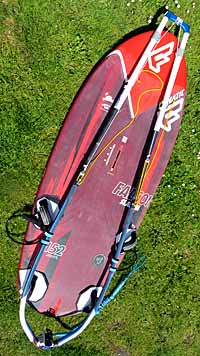
Verdict.
To summarize according to the listed criteria and findings:
1. Made from carbon? ....................................................... Yes (a very high quality carbon).
2. Monocoque construction? ............................................. Yes.
3. No boom sliding. .......................................................... Check (iFront 1.0 & iFront 2.0).
4. Clamp mechanism friendly to the mast? ....................... Yes (at least iFront 2.0).
5. No water in the boom. .................................................. Check (very convincingly).
6. Relatively narrow between the tubes. ........................... Yes.
7. Classic shape. ............................................................... Yes.
8. Max. stiffness. .............................................................. Check (very stiff).
9. Prepared for outhaul trim. ............................................ Check (prepared for loop-loop-go)
10. Smart, strong and tight extension system. .................. Yes (paramount!).
11. Quality grip. ................................................................ Check.
12. A place for fastening the uphaul line. .......................... Check (very userfriendly).
13. Pivoting boom head. ................................................... OK.
14. Front diameter allows boom head interchangeability. . OK.
This is no durable
test, but in this early stage of the life of my Platinum boom it has
indeed proven a very, very promising performance. It's pretty seldom
I've taken some new windsurf gear into
possession without finding any major flaws. But that's the case with
this
boom.
The North Platinum
boom certainly doesn't come cheap
(in my country). But with the current experience I'll
rather save up money to be able to buy a North Platinum boom tomorrow
than buy a cheaper carbon boom from any other brand today.
